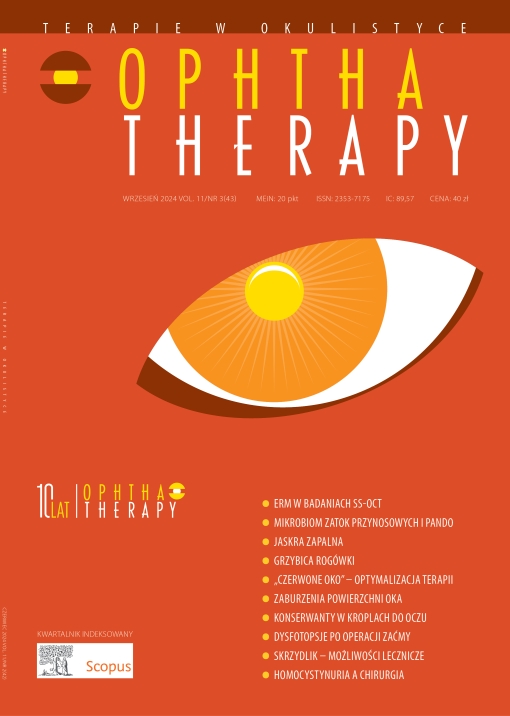Optymalizacja opieki nad pacjentem z czerwonym okiem: nowy kierunek leczenia Zapiski z wykładu
##plugins.themes.bootstrap3.article.main##
Abstrakt
Zaczerwienienie oka może być efektem lub objawem różnych schorzeń narządu wzroku bądź pojawiać się bez uchwytnego powodu. W przypadku czerwonego oka postępowanie terapeutyczne opiera się na właściwym postawieniu rozpoznania i w miarę możliwości na leczeniu przyczynowym.
Strategie terapeutyczne w miejscowym przekrwieniu spojówek opierają się również na przeciwdziałaniu poszerzeniu naczyń i tym samym na zmniejszeniu objawu czerwonego oka.
Rozszerzenie naczyń zależne jest od receptorów α-adrenergicznych. Dwie klasy receptorów adrenergicznych w oku to: receptory α1- i α2-adrenergiczne, które odpowiadają za napięcie naczyniowe spojówki. Efektem końcowym wiązania agonistów z receptorami α1- i α2-adrenergicznymi jest zwężenie naczyń. Jednakże stosowanie leków zwężających naczynia krwionośne wiąże się z występowaniem tachyfilaksji, czyli spadku skuteczności działania wraz z długotrwałym stosowaniem, i efektu z odbicia definiowanego jako przekrwienie, które nasila się jeszcze bardziej po przerwaniu leczenia. Wprowadzenie do leczenia brymonidyny o niskim stężeniu, która jest selektywnym agonistą α2-adrenergicznym, spowodowało złagodzenie tych efektów, co jest spowodowane również działaniem na naczynia żylne i niewywoływaniem objawu niedotlenienia tkanek. W porównaniu z innymi lekami zwężającymi naczynia brymonidyna daje nadzieję pacjentom z objawami czerwonego oka na poprawę stanu miejscowego i jakości życia.
Pobrania
##plugins.themes.bootstrap3.article.details##
Copyright: © Medical Education sp. z o.o. License allowing third parties to copy and redistribute the material in any medium or format and to remix, transform, and build upon the material, provided the original work is properly cited and states its license.
Address reprint requests to: Medical Education, Marcin Kuźma (marcin.kuzma@mededu.pl)
Bibliografia
2. Bonini S. The red eye. Eur J Ophthalmol. 2021; 31(6): 2843-9. http://doi.org/10.1177/11206721211024827.
3. Hosten LO, Snyder C. Over-the-Counter Ocular Decongestants in the United States - Mechanisms of Action and Clinical Utility for Management of Ocular Redness. Clin Optom (Auckl). 2020; 12: 95-105.
4. Burke D. What You Need to Know About Eye Redness.
5. Rahman MQ, Ramaesh K, Montgomeryt DMI. Brimonidine for glaucoma Expert Opin Drug Saf. 2010; 9: 483-9.
6. Pasquali TA, Aufderheide A, Brinton JP et al. Dilute brimonidine to improve patient comfort and subconjunctival hemorrhage after LASIK. J Refract Surg. 2013; 29: 469-75.
7. McAuliffe-Curtin D, Buckley C. Review of alpha adrenoceptor function in the eye. Eye (Lond). 1989; 3: 472-6.
8. Guimarães S, Moura D. Vascular adrenoceptors: an update. Pharmacol Rev. 2001; 53(2): 319-56.
9. Greenfield DS, Liebmann JM, Ritch R.: Brimonidine: a new alpha2-adrenoreceptor agonist for glaucoma treatment J Glaucoma. 1997; 6(4): 250-8.
10. Vaajanen A. Vapaatalo H. A Single Drop in the Eye – Effects on the Whole Body. The Open Ophthalmology Journal. 2017; 11: 305-14.
11. Potter DE, Crosson CE, Heath AR et al. Review: alpha 2 and DA2 agonists as antiglaucoma agents: comparative pharmacology and clinical potential. J Ocul Pharmacol. 1990; 6(3): 251-7. http://doi.org/10.1089/jop.1990.6.251.
12. Toris CB, Gleason ML, Camras CB et al. Effects of brimonidine on aqueous humor dynamics in human eyes Arch Ophthalmol. 1995; 113: 1514-7.
13. Fowler J Jr, Jackson M, Moore A et al. Efficacy and safety of once-daily topical brimonidine tartrate gel 0.5% for the treatment of moderate to severe facial erythema of rosacea: results of two randomized, double-blind, and vehicle-controlled pivotal studies J Drugs Dermatol. 2013; 12: 650-6.
14. Melamed S, David R. Ongoing clinical assessment of the safety profile and efficacy of brimonidine compared with timolol: year-three results. Brimonidine Study Group II. Clin Ther. 2000; 22: 103-11.
15. McLaurin E, Cavet ME, Gomes PJ et al. Brimonidine Ophthalmic Solution 0.025% for Reduction of Ocular Redness: A Randomized Clinical Trial. Optom Vis Sci. 2018; 95: 264-71. http://doi.org/10.1097/OPX.0000000000001182.
16. Torkildsen GL, Sanfilippo CM, DeCory HH et al. Evaluation of Efficacy and Safety of Brimonidine Tartrate Ophthalmic Solution, 0.025% for Treatment of Ocular Redness. Curr Eye Res. 2018; 43(1): 43-51.
17. Ackerman SL, Torkildsen GL, McLaurin E et al. Low-dose brimonidine for relief of ocular redness: integrated analysis of four clinical trials. Clin Exp Optom. 2019; 102(2): 131-9.

